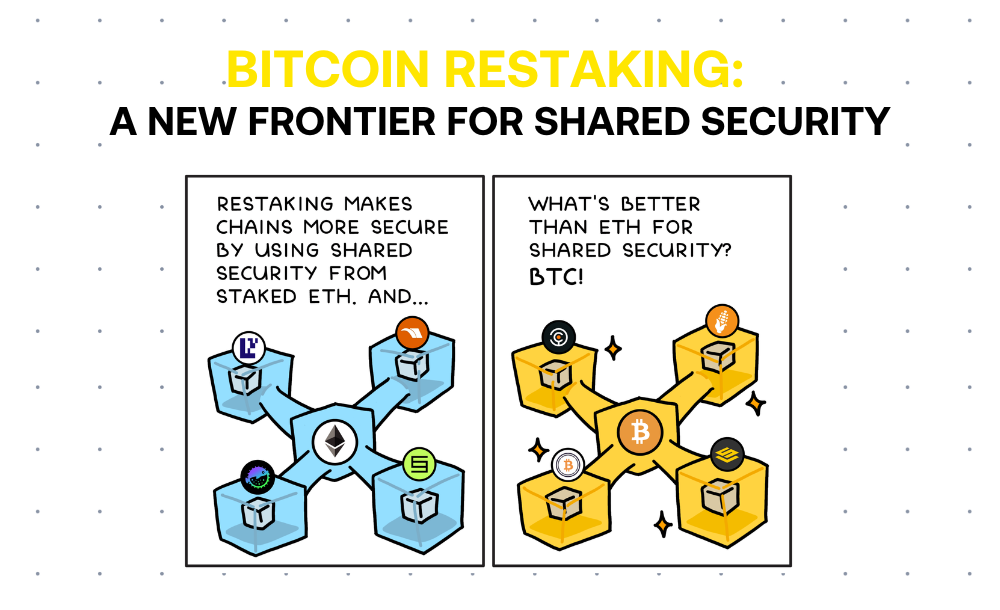What’s the Point of Bitcoin Restaking?
The idea behind Bitcoin restaking is to take the properties that make BTC so precious and extend them to new networks, ecosystems, and dapps.

Bitcoin has many things in its favor. It’s valuable. It’s secure. It’s liquid. It’s widely accessible. But it also has a few things that count against it. Short of hodling hard and waiting for it to appreciate, there’s not a whole lot you can do with BTC.
This is a feature, not a bug: Bitcoin has been optimized to do one thing: to serve as sound money, with its value driven by a provably scarce supply and unrivaled security model. But just imagine what could be done with Bitcoin if it was as versatile as, say, ETH? Imagine the new networks that could be secured, the stablecoins collateralized, and the use cases unlocked if Bitcoin operated as a yield-generating asset?
With the rapid expansion of BTCFi innovations — spanning Ordinals, Runes, Bitcoin Layer 2 solutions, and Babylon driving $5 billion in staked BTC TVL — Bitcoin builders are swiftly capitalizing on its immense potential. That, in a nutshell, is the idea behind Bitcoin restaking as pioneered by SatLayer: to take the properties that make BTC so precious and extend them to new networks, ecosystems, and dapps. It’s an attempt to capture all the best bits of Bitcoin coupled with the flexibility of smart contract networks to support an array of decentralized applications with robust security at their core.
At a high level, this is a concept that’s easy to grasp. But how does Bitcoin restaking work in practice? And can it achieve these lofty goals without exposing BTC to systemic risk?

The Bull Case for Bitcoin Staking and Restaking
Popularized by Babylon and with over $5 billion in Bitcoin already staked, Bitcoin staking is an emerging financial primitive. It enables Bitcoin — the most decentralized and influential cryptocurrency — to be used as collateral for securing Proof of Stake (PoS) blockchains against equivocations, such as double signing or double spending, where validators sign two conflicting blocks at the same height.
Restaking means taking an already staked or locked-up crypto asset and using it to secure another network or service. In other words, using collateral that’s already pledged somewhere else but is still recognized as valid in a new context. This approach enhances capital efficiency by allowing a single asset to protect multiple layers or protocols.
Until recently, the concept of restaking was synonymous with EigenLayer on Ethereum, where staked ETH or liquid staking tokens (LSTs) could be put to work securing secondary layers. ETH restaking has proven itself to be secure and versatile, making it an attractive option to institutional and retail users alike, who can earn additional yield on their staked assets while helping to secure emerging web3 protocols.
With almost $2T in idle capital, what’s to prevent Bitcoin from being repurposed in the same way?
Shared Security Through Restaking
Shared blockchain security is the idea that multiple networks or dapps can lean on the same robust security model, reducing duplication of effort. For instance, rather than each new chain spinning up its own PoS token and hoping it garners enough value to deter attacks, restaking leverages an existing, high-value asset.
Ethereum’s restaking has shown how capital efficiency can skyrocket when many protocols are shielded by the same underlying stake. Bitcoin, with its enormous market capitalization and deeply decentralized hash power, could offer an even stronger security foundation to emerging blockchains or off-chain services.
Moreover, BTC’s status as a “reserve asset” within the crypto industry gives it universal acceptance and trust. By repurposing BTC for restaking, developers can integrate not just a robust security layer, but an asset whose value is indisputable. This synergy will open doors for new DeFi use cases, cross-chain applications, and advanced services for whom security is paramount.
It Begins With Babylon
Until recently, Bitcoin lacked a universal framework for staking but that’s all changed with the launch of Babylon. For the first time, BTC holders can earn yield from their bitcoins through a highly secure framework that entails no reliance on third-parties or complex bridging. Trustless staking, with no custodial risk, is the breakthrough that enables Bitcoin to be put to work to secure secondary and tertiary protocols. And SatLayer, built on Babylon, is the means by which that is achieved.
Babylon’s liquid staking solution partners such as Solv, Lombard, Lorenzo Protocol enables BTC holders to stake their assets and contribute to network security via Babylon Chain and earn rewards while still retaining the flexibility to trade a tokenized representation of those staked funds. In essence, the protocol mints a new “liquid staking token” (LST) that mirrors the value of the staked asset. This token can then be deployed across other DeFi services or traded on secondary markets. The holder’s original assets remain staked in Babylon, but they maintain liquidity through the freely available LST.
One of the primary use cases that Babylon LSTs unlock are restaking: the ability to use a staked asset – in this case BTC – to secure additional web3 protocols. This is achieved through Satlayer, which is a set of smart contracts built on top of Babylon that enable restaking of Babylon staked assets. How Bitcoin Restaking Works
SatLayer allows BTC owners to participate in staking-based activities without altering Bitcoin’s base-layer consensus. This not only creates additional yield opportunities for BTC holders but empowers a new wave of dApps secured by the gold-standard and gold-analogous digital asset with unmatched liquidity.
Through Babylon, Bitcoin holders can self-generate and lock their BTC into a Bitcoin staking vault, using it as slashable collateral to secure PoS blockchains that opt into Babylon’s security model. In essence, Babylon allows any Bitcoin holder to trustlessly secure PoS blockchains via a slashable safety mechanism. SatLayer extends Babylon’s functionality by leveraging its slashable safety guarantees to power its own restaking protocol. This protocol transforms restaked Bitcoin into programmable, slashable collateral, significantly expanding Bitcoin’s security applications and unlocking its full potential as a reward-generating asset
Over the last 15 years, Bitcoin has achieved great things but the majority remains trapped on its native network. Freeing those trillions of dollars in idle capital, allowing them to be put to use in securing other crypto networks, would extend Bitcoin’s utility without materially increasing surface risk. The ability to earn yield on BTC holdings by staking it, while retaining the non-custodial properties that are integral to Bitcoin’s entire value proposition, is a genuine game-changer.
Thanks to Babylon, secure Bitcoin staking is now possible. And thanks to SatLayer, secure Bitcoin restaking is also now within reach. As a result, developers are free to create the decentralized applications they’ve always dreamed of, underpinned by the value and liquidity of the Bitcoin network.
Follow SatLayer
Join us on our Journey to Testnet 🫡
- Apply as a BVS developer and get Devnet access: https://bit.ly/4hQ6UnL
- Read technical docs: https://docs.satlayer.xyz/
- Get the latest updates: https://x.com/satlayer
- Follow us on LinkedIn: https://www.linkedin.com/in/satlayer
- Join the SatLayer community: https://discord.com/invite/G9NSU9pEWj
- Subscribe to Telegram: https://t.me/satlayerannouncements

